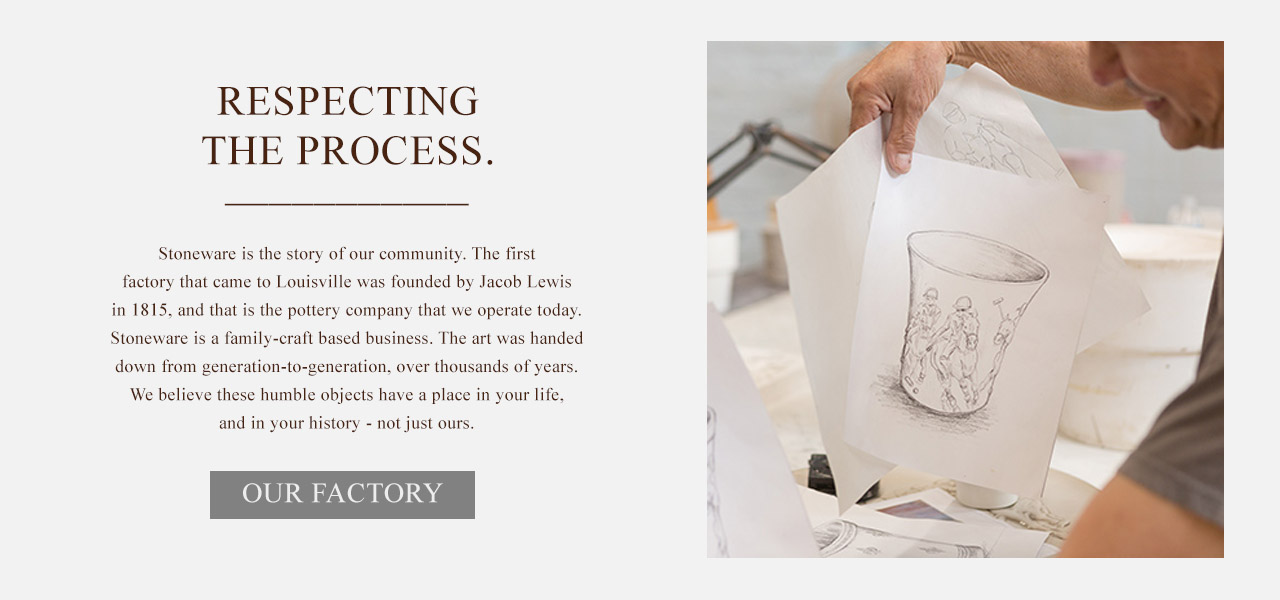
The richness of raw materials. The perfection of a basic form. The poetry of a hand-applied brush stroke. In our machine-driven age, these natural and simple essences seem to have become a lost art. Since our early beginnings, we have been dedicated to the craft of transforming clay into enduring, functional stoneware pottery art forms. Working with the basic elements of earth, water, air and fire, skilled artisans create timelessly beautiful dinnerware, bakeware, flowerpots and serving pieces that can be enjoyed and cherished for generations. Some designs are subtle—others are more striking and exuberant—but what they all have in common is an underlying belief that humble, everyday objects have an important place in our lives and homes.
OUR HISTORY
As the British ships retreated for a second time, the War of 1812 came to a close and the United States began a fifty-year period of peace and the great experiment of “democracy” could resume. This period known as the Antebellum period would see the end to Indian hostilities in the Ohio Valley making it safe for settlers and their families to live in peace. Some forty years earlier George Rogers Clark establish the sleepy little river town of Louisville Kentucky in 1778 on the Falls of the Ohio; unaware that this impediment to river traffic would become Louisville’s biggest asset.
Napoleon Bonaparte was sent into exile on the island of St. Helena in 1815. The end of the Napoleonic Wars established peace in Europe for the first time in hundreds of years. This started a wave of immigration to America of approximately 5 million people from 1815 to 1845. The pre-famine emigration from 1815 to 1845 was predominantly one of bilingual or English-speaking farmers, artisans and townsmen travelling in family groups. Emigrants of this description continued to leave during the rest of the century, but each year before the famine saw a rise in the number of poorer emigrants from the overwhelmingly Roman Catholic rural districts of Connaught and Muster, culminating in the massive exodus of 1845-1853 as the failure of crops in Europe set in a continent wide famine.
In the 18th Century early pioneers would use the swollen rivers of the spring rains to float their goods to the Ohio River. A flatboat trip down the Ohio River from Pittsburgh to New Orleans took about eight weeks and was a one-way adventure. When the flatboats reached the Falls of the Ohio at Louisville, their goods and boats would be off-loaded and transported by land to the lower-end of the falls. When and if their goods successfully landed in the port of New Orleans the long journey home by foot or horse would take several months.
Robert Fulton built the steamboat New Orleans, which became the first steamboat to arrive in New Orleans in 1811, traveling downstream from Pittsburgh. Although it made the trip in record time, most believed its use was limited, as they did not believe a steamboat could make it back upriver against the current. With the arrival of Fulton’s New Orleans, a new age of growth for Louisville and its distilling industry began. The steamboat allowed for the expanded distribution and in larger quantities of whiskey, a type of barrel-aged distilled spirit made primarily from corn, to new markets. In 1815 the Enterprise, a small steamboat captained by Henry Miller Shreve, became the first to travel from New Orleans to Louisville, showing the commercial potential of the steamboat in up-river travel and shipping.
Young immigrant families moved west in great numbers searching out new opportunities and claiming rich farmlands of the Mid-west. Their families, transported by mechanized water travel via the steamboat, turned the sleepy little river town of Louisville Kentucky into a major hub of trade and commerce. By 1840 Louisville’s population had swelled to well over 20,000 citizens and would continue to grow tenfold until the turn of the century.
In 1815 a young potter by the name of Jacob Lewis established the Lewis Pottery not far from the river edge on Billy Goat Strut Alley, got it name from an entertaining pastime of betting on the billy goat races. Jacob Lewis was about to experience a perfect storm as millions of immigrants collided at the Falls of the Ohio. Lewis was there to supply what was the main storage or the “Tupperware” of its day. Travelers heading west would stock up on supplies and the only storage containers that would protect their precious cargo of sugar, flour or whiskey would be made of Stoneware. Large 30 gallons crocks would be filled with grain and sealed with a wooden top and beeswax to keep the rats from damaging their goods. Lewis also produced every day necessities such as butter churns, bowls and plates that were less expensive than the pewter plates of the day.
Stoneware is a type of pottery fired to a high temperature (about 1,200°C to 1,315°C). While it originated in the Rhineland area of Germany around the 1400s, it became the dominant house-ware of the United States circa 1780-1890. Americans began producing Salt-Glazed Stoneware about 1720 in Philadelphia, Pennsylvania and Yorktown, Virginia. There the Crolius and Remmey families (two of the most important families in the history of American pottery production) would, by the turn of the 19th century, set the standard for expertly crafted and aesthetically pleasing American Stoneware.By the 1770s, the art of salt-glazed stoneware production had spread throughout the United States. American Stoneware pottery was usually covered in a salt-glaze and often decorated using cobalt oxide to produce bright blue decorations.While other types of Stoneware were concurrently produced in America – such as ironstone, yellowware and various types of china – in common usage of the term, “American Stoneware” refers to this specific type of pottery.
By 1820, stoneware was being produced in virtually every American urban center, with potters from Maryland to Kentucky. Commercial distilleries in the Kentucky’s rural areas were on the rise, as was Louisville’s Stoneware industry, which produced the jugs used to package the region’s precious bourbon. Bourbon was sold to general stores and saloons in wooden barrels. Customers brought Stoneware jugs to be filled, and the proprietors quickly grabbed onto this marketing opportunity. They had Stoneware jugs printed with the name of their establishments for store customers to buy and have filled, and refilled, for the cost of the bourbon.
The Civil War tore the United States in half with two famous Kentuckians, Abraham Lincoln and Jefferson Davis, leading each side. While the City of Louisville was just south of the Mason Dixon line it was a stronghold for the Union Army, which kept Kentucky firmly in the Union. It was the center of planning, supplies, recruiting and transportation for numerous campaigns, especially in the Western Theater. While the state of Kentucky officially declared its neutrality early in the war, prominent Louisville attorney James Speed, brother of President Abraham Lincoln’s close friend Joshua Fry Speed, strongly advocated keeping the state in the Union.
Seeing Louisville’s strategic importance in the freight industry, General William Tecumseh Sherman formed an army base in the city in the event that the Confederacy advanced. The Louisville Pottery would be a major supplier of storage containers for Union troops. “If you can’t feed your army you can’t fight. A stoneware pottery and its storage containers were a strategic asset during war as it was the only way to safely transport valuable food supplies to the troops. On “Sherman’s March to the Sea” he strategically destroyed the potteries of the South and all types of food storage vessels. Most of the southern potteries would never recover.
As the 19th Century came to a close as heavy stoneware crocks and jugs fell out of favor and tin cans and glass containers became the storage containers of choice. Within the next decade most of the Stoneware factories in the United States would close their doors. The Lewis Pottery changed hands many times over the two hundred years and found itself to find a new source of revenues as it entered the 20th Century. James Bauer who operated under the name of Bauer Pottery, Cherokee Pottery and Louisville Pottery. John B. Taylor acquired the pottery in 1938 and formed the JB Taylor Company. He
placed his name on the bottom of the pieces and transformed the pottery into a major supplier of dishware, flowerpots and bakeware. Under John Taylor’s leadership new patterns and shapes were created. He marketed his dishes throughout the country and created several designs that are still produced today at Louisville Stoneware. During this period Mary Alice Hadley worked at the JB Taylor Company and started her career as one of the greatest designers of folk art patterns in the history of American Stoneware. Hadley had a “falling out” with Taylor and started the Hadley Pottery early in 1940. Mary Alice’s original pieces are highly sought after by collectors.
Many patterns have come and gone over the years with several still painted by our artist today. Corn Flower Blue, originally called Cornflower, what’s now known as one of the most popular patterns – Bachelor Button – was created during Taylor’s tenure by artist Edith Ellis. According to our history, Mamie Eisenhower had this pattern as her every day dishes in the White House. John Robertson, a ceramics engineer, saved the pottery from closing after the death of Taylor in 1970 and changed the name to Louisville Stoneware.
Christy Lee Brown took over stewardship of Louisville Stoneware in 1997. Combining her love of the arts and her family deep tradition in Kentucky she transformed the company with an updated look and feel. Changes included new branding, updating the showroom, adding factory tours and creating a new internet strategy for the company. Brown understood the importance of infusing new designs and style into portfolio of Louisville Stoneware. Her collaboration with David Mahoney created several new patterns including Augusta, Flora and Graffiti. Brown’s vision not only saved this 200-year-old tradition, but also placed it firmly on a path for the future.
Stephen A. Smith became the steward of Louisville Stoneware in 2007. The Stoneware team executed on Brown’s vision and continued the tradition of Louisville Stoneware boosting custom, corporate, wholesale, retail and internet sales while educating customers on the manufacturing process, artistry, durability and functionality of Stoneware pottery. As a small, locally owned business with just over three-dozen employees, the product that the Stoneware Art Factory makes in its Paristown Pointe factory is used by customers around the country and the world. As the team takes one of the last remaining great American pottery companies into its third century of business, an important part of the company’s mission is to bring awareness to its rich history and to the artists who hand make and hand paint every piece.
“While we look toward the future, we are always respectful of the past,” said Smith. “I am honored to be part of this Great American Treasure. Everyone on the team at Stoneware is dedicated to creating a great experience for the most important people in our company…our CUSTOMERS.”


INSPIRE YOUR SOUL
These humble objects have a place in your life…
O U R C O M P A N Y
OUR COMPANY MISSION
IN-STORE EVENTS
V I S I T U S
731 Brent Street,
Louisville, KY 40204
Hours:
Monday - Saturday
10am - 4pm
Sunday
11am - 3pm
C U S T O M E R S E R V I C E
retail@louisvillestoneware.com
5 0 2 . 5 8 2. 1 9 0 0

